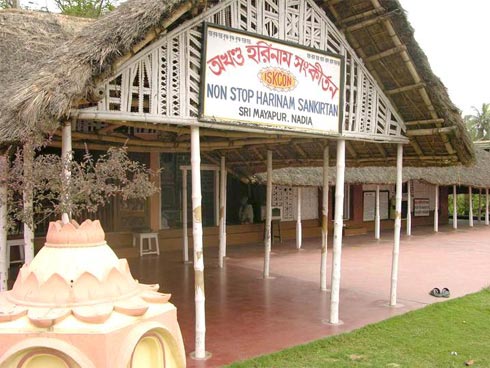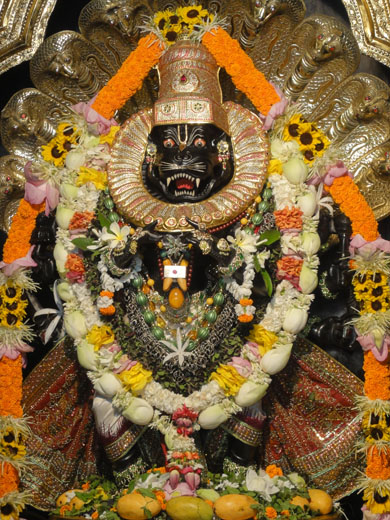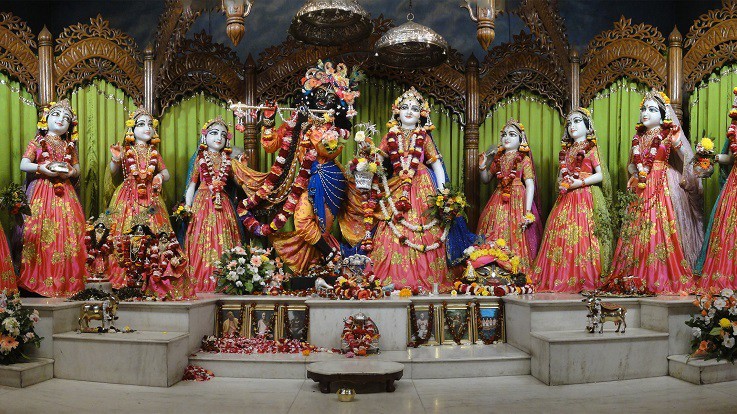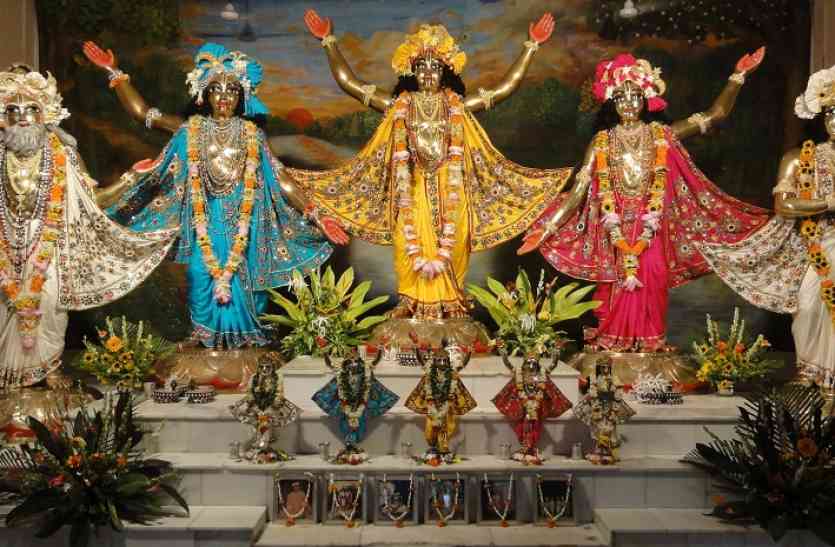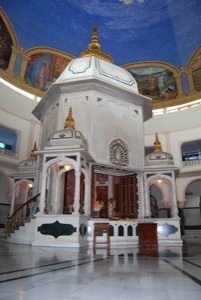Mayapur
Mayapur is a village on the east bank of the holy river Ganges. It’s approximately 130 km north of Kolkata and across the Ganges from the city of Nabadwip. Nabadwip is the birthplace of Sri Krishna Chaitanya, who was born in 1486 who is non other than Krishna Himself and he is the one who started the Hare Krishna movement; he was the first to teach widespread mass chanting and singing of the Hare Krishna mantra.
Srivas Angan:
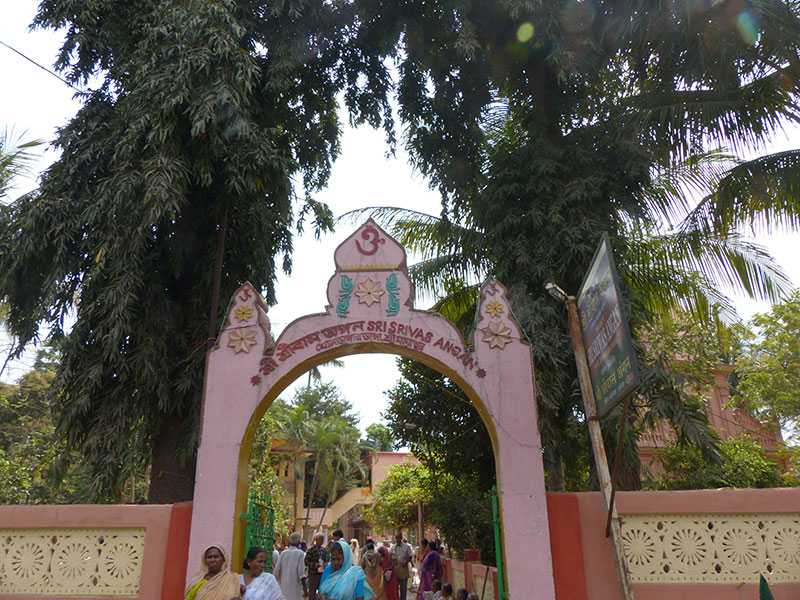
This is a small temple where the house of Srivasa Thakura was once located. The central altar is dedicated to Maha-prakasha-lila, a lila in which Lord Caitanya revealed to the devotees His Divine nature (this happened at this very place). Lord Caitanya is sitting on a throne, Gadadhara Pandita is fanning him with a chamara, and Lord Nityananda holds an umbrella over His head.
Gaura Nitai leading kirtan are installed on the right altar. This altar is dedicated to the procession to the house of Kazi, which was headed by Lord Caitanya and Nityananda.
At Srivas Thakur’s house there is a place known as Khol-banga-danga, “the place where the drums were broken.” The altar here reminds devotees of how the Muslim Kazi soldiers tried to stop the sankirtan in Navadvipa, which served as the impetus for the beginning of the civil disobedience movement organized by Lord Caitanya.
Both Srivasa Thakur and his wife Malini Devi were very close friends of Sacimata and Jagannath misra. It was by the loud and pitiful cry of Advaita Acharya and Srivasa Thakur that the supreme Lord descended as Chaitanya Mahaprabhu. Srivasa and Malini Devi nurtured and raised Mahaprabhu with great parental affection. Sri Gaurasundara accepted Srivasa and Malini as a second father and mother.
The Lord after returning from gaya, performed many pastimes at the house of Srivasa. He started day and night Kirtan, displayed his Mahaprakasa lila and granted many benedictions to many devotees, he also started the first Nagar sankirtan to the palace of Chand Kazi from the house of Srivasa thakura. Even today we can see the mridanga that was broken by the Kazi in his attempt to stop the Harinam Sankirtan.
Yogapitha:
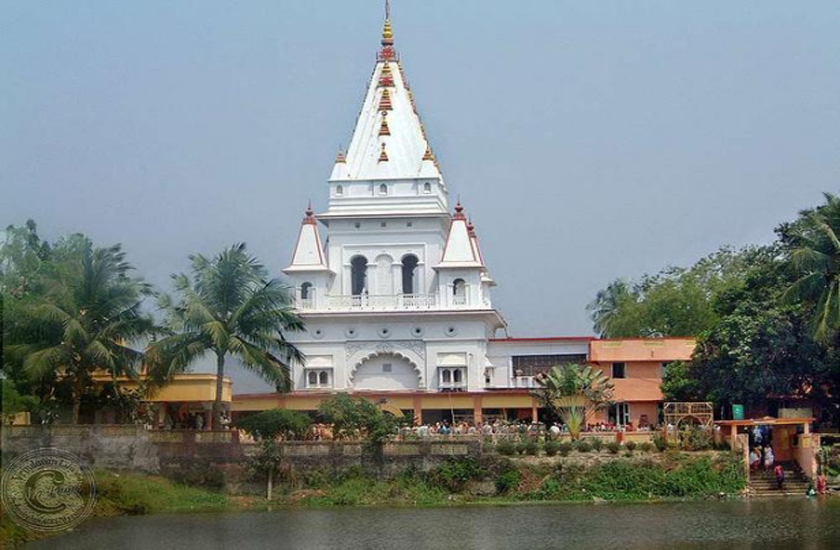
Sri Chaitanya Mahaprabhu’s birthplace, is known as the Yogapitha, it is on the banks of the holy Ganga and was discovered by the 19th Century Vaisnava saint, Srila Bhaktivinoda Thakura. The Thakura built a beautiful temple here with the Deities of Mahaprabhu and His consorts Visnupriya and Laksmipriya, and Radha-Madhava.
There is also a neem tree in the courtyard that is the exact spot where Lord Caitanya was born. There are also Deities of Mahaprabhu as a child along with His parents, Saci-devi and Jagannatha Misra.
Bhaktivinoda Thakura’s son and spiritual successor, Bhaktisiddhanta Sarasvati Thakura, built the present temple in 1934. It was inaugurated on Gaura-Purnima day at which time Bhaktisiddhanta Sarasvati Thakura installed the remaining Deities on the left and right altars.
Chand Kazi Samadhi:
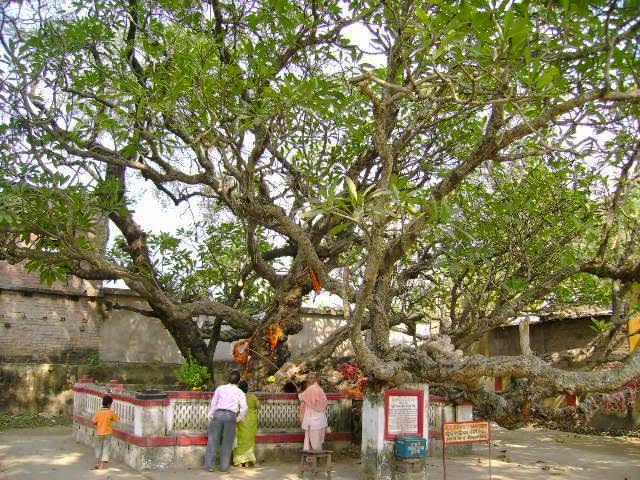
The stone samadhi of Chand Kazi has two trees growing out of it. The champaka tree is said to represent Chand Kazi (who was also known as Champa). It is over 500 years old and therefore witnessed the events of Chand Kazi’s pastimes with the Lord. Even though the trunk of this tree is hollow, it is still in full bloom and gives champaka flowers all year round, even when it is not flowering season. The neem tree around the champaka tree is said to represent Lord NImai (Caitanya ) who is in ecstasy embracing the great devotee Chand Kazi. This area is the village of Chand Kazi, which is none other than Mathura of Vrindavana. Just by seeing this samadhi, one is released from old age and death.’ Being Mathura, this place is more auspicious than Vaikuntha and by residing here for one day, a person will develop devotional service to the Lord.’
Jagannatha Mandir:
Five hundred years ago, at the time of Lord Chaitanya, there lived a very wonderful devotee named Jagadish Ganguli. His residence was in a small village near Mayapur. Although he was advanced in age, every year he would go on the 900 kilometer journey to Jagannath Puri on foot to associate with his master Sri Chaitanya Mahaprabhu, take darshan of his beloved Jagannatha, Baladeva and Subhadra Devi, and participate in the all-auspicious Ratha-yatra festival.
One day, less than a month before his scheduled departure for Puri, Jagadish’s plans were foiled. He was stricken with a terrible disease that left him completely blind. Because he was optimistic by nature, this did not dampen his desire to make the yearly padayatra to Puri. He would no longer be able to see the divine, all-merciful forms of Lord Chaitanya and Lord Jagannatha, that was for sure. But still he could relish the sound of sweet kirtana and discourses given by exalted Vaishnavas.
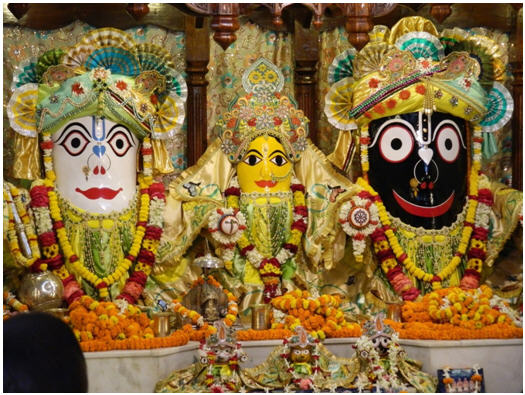
Then, one night, Lord Jagannatha appeared to his devotee in a dream. The Lord told him that on the following day when he went for his daily bath in the Ganges, a log would touch his head and restore his vision. The Lord instructed Jagadish to take that log to a nearby village and request a certain devotee carpenter there to carve a Deity of Lord Jagannatha. The Lord also explained that at first the carpenter would refuse to do the work because he was a leper and his hands were very deformed. It was Jagadisha’s task to convince him to do the service. The Lord assured him that when the carpenter had completed the Deity his leprosy would be cured.
At the break of dawn Jagadish woke from his dream and marveled at it. Eagerly he readied himself for his daily bath. He paid his obeisances to Mother Ganga and then entered her sacred waters. Lord Jagannatha’s words were quickly proven true. A log touched his head and promptly restored his vision. Enlivened by the Lord’s shower of mercy, he took the log and quickly proceeded towards the nearby village. After many hours, an exhausted Jagadish found the leper carpenter, who flatly refused to carve the Deity.
He showed his deformed fingers and asked his expectant customer, “How is it possible for me to carve the divine form of the Lord with these hands?” An intense exchange followed, each devotee speaking his mind. Finally the leper agreed to carve Lord Jagannatha.
Jagadish lived with the devotee leper carpenter while he was carving his Lord. He saw him suffering terribly. Blood and pus oozed from the stumps that were once his fingers and his face was distorted by pain. He wanted to stop this torturous work. Somehow or other Jagadish managed to convince him to continue and constantly spoke to him the pastimes of his beloved Lord Jagannatha to distract his mind from the pain. Finally the Deity was completed and to his amazement, the devotee leper was cured of his leprosy.
ISKCON Mayapur Campus:
- Sri Sri Radha Madhava temple complex
- Srila Prabhupada’s Pushpa Samadhi Mandir
- Srila Prabhupada’s Bhajan Kutir
- Goshala
Ganga Boat Ride: Prabhupada Ghat
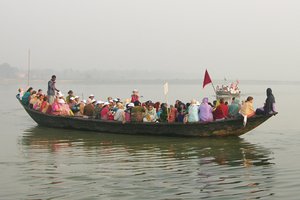
Prabhupada ghat (steps leading to the river) can be called the main ISKCON access to Ganga. There is a temple of the Ganga Mata here.
Ganga Puja is performed on the river bank. The pujari offers fire to the Ganges and performs puja to the sound of gongs. At the end, anyone can offer the river a lamp and a flower, as well as get mahaprasad.

